
Once the new year started, I wanted a fresh start so I began working out more and even cut my hair into a cropped bob.
Big mistake. It became really cold not long afterward and my scalp became so dry it felt like it had turned into the Sahara desert. No joke.
(MORE: What to know about scalp facials))My natural hair texture is tightly-coiled when washed. I usually have it blown straight, but when I exercise my scalp usually sweats and makes my hair revert back to its natural curl pattern. Intense workouts also seemed to be leading to lots of moisture loss from my scalp. What did this all mean for me? Dryness, dandruff, and even some light flaking.
The top reasons for dry scalp include weather changes, stress, and certain medical conditions, board-certified dermatologist Melanie Palm told "Good Morning America."
"Many times, people confuse dry scalp with seborrheic dermatitis, also known as dandruff, which is characterized by skin flaking and some degree of scalp irritation," she said. "There are serious medical conditions that can mimic seborrheic dermatitis and dandruff can be a sign of other underlying medical conditions that should be further addressed or treated."
Palm said "dry scalp may feel tight or itchy, but shouldn't have much flaking. Dandruff, on the other hand, is an inflammatory condition because there is inflammation of the skin present. Abnormal growth of yeast on the skin on the skin surface also contributes to this."
While I don't have any medical conditions, I also began to notice the constant blow drying and use of hot tools were not only drying my scalp but the texture of my hair was being compromised as well -- which seemed to be escalating my issue.
My dry scalp situation was on a continuous downward spiral and I was desperate for a solution.
To remedy this, in January I went on a quest to find the best product for my scalp. I searched high and low, from fancy scalp scrubs to natural remedies such as rinsing with apple cider vinegar. I bought about five different products, tried them all and nothing worked.
(MORE: Good Housekeeping's top picks for curling irons)Most of the products I tried worked sometimes but failed me at other times. I needed something that would consistently work.
It wasn't long afterward that I found Head & Shoulders Royal Oils Moisture Boost shampoo and a matching conditioner under the same line. On the bottles, the claim for "long-lasting scalp relief" intrigued me and I decided to give it a try, but also do a little more precautionary research before experiencing another failed attempt at soothing my scalp.
I decided to bring the Head & Shoulders duo mentioned earlier with me to my local salon and gave it to my hairstylist to try on my hair.
(MORE: 7 tips for choosing the right shampoo)After a few rounds of washing and one comb through with the conditioner, she blurted out: “Yeah, girl, this stuff is really good for your scalp!”
One of the main ingredients in the Head & Shoulders shampoo and conditioner I tried is zinc pyrithione which Palm advises is anti-inflammatory and highly effective ingredient when treating issues such as dandruff and seborrheic dermatitis.
One of the main ingredients in the Head & Shoulders shampoo and conditioner I tried is zinc pyrithione which Palm advises is anti-inflammatory and highly effective ingredient when treating issues such as dandruff and seborrheic dermatitis.
After using the products, I waited in fear that dryness, flakes or dandruff would find a way creep up. Surprisingly, almost two weeks went past since I had a new wash and my scalp still felt great, with barely any dry spots or flaking and no itchiness whatsoever. It's a miracle I haven't had to sneak away to scratch my head and I'm thankful the dry scalp spell has finally passed.
(MORE: How to use fats and oils for healthy hair, skin)Overall, I was a happy customer and will be buying more once my bottles are empty. The entire Royal Oils collection is available nationwide at mass retailers with their shampoo starting as low as $7.